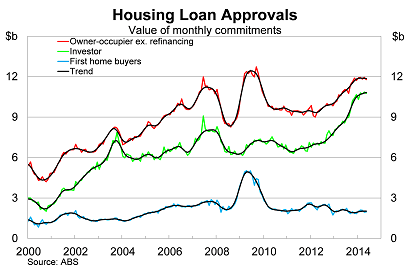How investors burned a hole in the housing market
Lending growth continues to moderate, suggesting that the housing market will soon reach its cyclical peak. Unfortunately, with owner-occupier and investor activity so high and the broader economy much weaker, we run the risk of a housing downturn that exceeds the 2008 and 2011-12 episodes.
The value of loan approvals to owner-occupiers, excluding refinancing, fell by 1.4 per cent in May to be 8.3 per cent higher over the year. The decline was mostly driven by softer volumes, which declined by 1.0 per cent, but the average loan size also fell modestly.
Refinancing of existing home loans remains strong, supported by historically low mortgage rates. With household indebtedness so high it is hardly surprising that households remain keen on easing their interest rate burden. The number of loans used for refinancing purposes rose by 2.1 per cent in May and has accounted for one-third of all loans to owner-occupiers over the past year.

One of the more important trends is that growth has slowed significantly for both owner-occupiers and investors since late 2013.
On a trend basis, loan approvals to owner-occupiers declined by 0.1 per cent in May (compared with growth of 1.7 per cent in October), while for investors, growth slowed to 0.3 per cent (compared with 3.9 per cent in September).
Low interest rates have encouraged owner-occupiers and investors to bring their purchases forward, but that process can be risky. If a market burns too brightly then it can leave a void, with few buyers left to keep house prices ticking along.
If that void cannot be filled -- and the graph above shows that it rarely is -- then total loan approvals will decline significantly and house prices, which are demand-driven, will follow suit.
Which raises the question, can the void be filled? And by what?
There are three leading candidates: first home buyers, foreign buyers and self-managed super funds. Unfortunately none of these factors are sufficient to offset a sharp fall in activity from investors and owner-occupiers.
The Australian housing market continues to price many younger Australians out and prospective first home buyers remain reluctant to take on excessive debt to make their dreams come true. Beyond the immediate aftermath of the global financial crisis, this is the worst time for Australians to take on excessive risk since our last recession in the early 1990s.
On a trend basis, the value of loan approvals to first home buyers rose by 0.1 per cent in May, to be 4.9 per cent lower over the year. At this stage they account for around 12.5 per cent of total loan approvals, remaining near their historic lows of late last year.
It is difficult to assess foreign demand simply because so little is known about foreign purchases of Australian real estate. We cannot discount the possibility that foreign demand could keep pressure on house prices but even in the most optimistic of estimates, foreign demand appears too small to offset a significant fall in lending activity.
The same can likely be said of SMSFs. I also suspect that housing will lose its desirability if a downturn becomes imminent. Rather than housing, they’ll be looking to ride out the poor weather with term deposits and bonds.
Lending activity is set to peak in the next few months, leaving the housing market somewhat vulnerable to a reversal of the strong house price growth that has characterised the past year. This recent upswing appears somewhat similar to earlier episodes that resulted in prices declining in 2008 and then again in 2011-12.
Unfortunately the Australian economy is weaker than during those earlier episodes, which may result in a sharper downturn this time around. Much will depend on whether the Reserve Bank of Australia can successfully facilitate the rebalancing of the Australian economy -- a process that has recently been derailed by the federal budget and a stubbornly high Australian dollar.
















